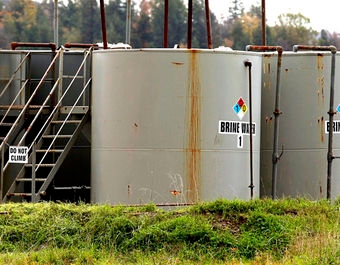New Waterless Fracking Method Avoids Pollution Problems
insideclimatenews.org/news/20111104/gasfrac-propane-natural-gas-drilling-hydraulic-fracturing-fracking-drinking-water-marcellus-shale-new-york
By Anthony Brino, InsideClimate News and Brian Nearing, Albany Times-Union
Nov 6, 2011
Little-noticed drilling technique uses propane gel, not water, to release natural gas. Higher cost, lack of data and industry habit stand in the way.

Tanks labeled as "Brine Water" on a property in Dimock, Pa. In conventional fracking, wastewater can be several times saltier than sea water and tainted with chemicals and mild radioactivity.
ALBANY, N.Y.—In the debate over hydraulic fracturing for natural gas, two facts are beyond dispute: Huge amounts of water are used to break up gas-bearing rock deep underground and huge amounts of polluted water are returned to the surface after the process is complete.
Tainted with chemicals, salts and even mild radioactivity, such water, when mishandled, has damaged the environment and threatened drinking water, helping fuel a heated debate in New York and other states over whether gas drilling is worth its risk to clean drinking water, rivers and streams.
Now, an emerging technology developed in Canada and just making its way to the U.S. does away with the need for water. Instead, it relies on a thick gel made from propane, a widely-available gas used by anyone who has fired up a backyard barbecue grill.
Called liquefied propane gas (LPG) fracturing, or simply “gas fracking,” the waterless method was developed by a small energy company, GasFrac, based in Calgary, Alberta.
Still awaiting a patent in the U.S., the technique has been used about 1,000 times since 2008, mainly in gas wells in the Canadian provinces of Alberta, British Columbia and New Brunswick and a smaller handful of test wells in states that include Texas, Pennsylvania, Colorado, Oklahoma and New Mexico, said GasFrac Chief Technology Officer Robert Lestz.
Like water, propane gel is pumped into deep shale formations a mile or more underground, creating immense pressure that cracks rocks to free trapped natural gas bubbles. Like water, the gel also carries small particles of sand or man-made material—known as proppant—that are forced into cracks to hold them open so the gas can flow out.
Unlike water, the gel does a kind of disappearing act underground. It reverts to vapor due to pressure and heat, then returns to the surface—along with the natural gas—for collection, possible reuse and ultimate resale.
And also unlike water, propane does not carry back to the surface drilling chemicals, ancient seabed salts and underground radioactivity.
“We leave the nasties in the ground, where they belong,” said Lestz.
Read Full Article
New Waterless Fracking Method Avoids Pollution Problems, But Drillers Slow to Embrace It

I like the Gras Frac Process – the process does not eliminate concerns about gas migration or movement of muds, but uses significantly less water, but increases the explosion hazard. Again – this is all about risk management.
Thanks on your marvelous posting! I actually enjoyed reading it, you may be
a great author.I will remember to bookmark your blog and will come back at some
point. I want to encourage continue your great work, have a nice holiday weekend!
Usually I don’t read post on blogs, but I wish
to say that this write-up very pressured me to check out and
do it! Your writing style has been amazed me. Thank
you, quite nice article.